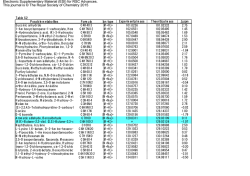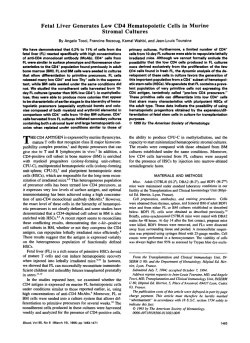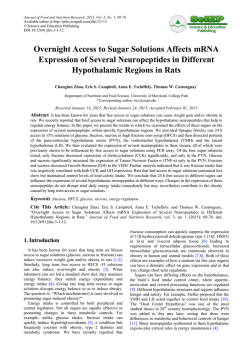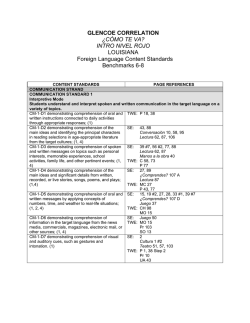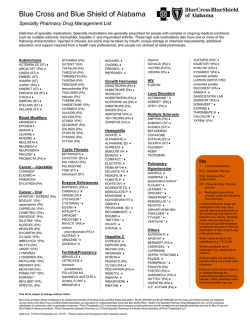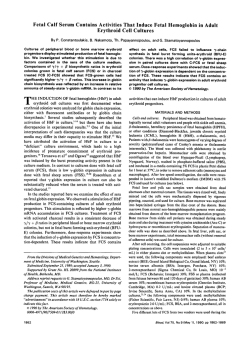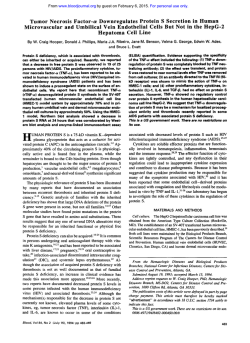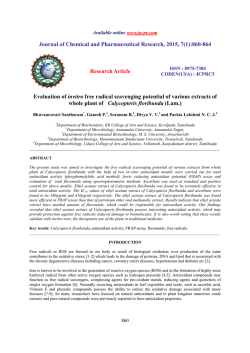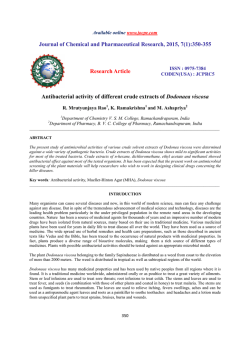
Microaerophilic property of Actinobacillus actinomycetemcomitans in
MICROBIOLOGY LE-ITERS FEMS Microbiology Letters 138 (1996) 191-196 Microaerophilic property of Actinobacihs actinomycetemcomitans in fructose-limited chemostat cultures Hiroyuki Ohta a’*, Daisuke Moriki b, Atsushi Miyagi a, Tatsuo Watanabe b, Keijiro Kato a, Kazuhiro Fukui a a Departmentsqf Microbiology,OkavamaCJnioersiO Dental School,Shikata-cho2-chome, Okayama 700, Japan b Departmentsof Preventive Dentistry, Okayama Unioersity Dental School, Shikata-cho 2.chome, Okayama 700, Japan Received 29 January 1996; revised 14 March 1996; accepted 14 March 1996 Abstract The effect of oxygen on the growth, metabolism, and leukotoxin production of Actinobacillus actinomycetemcomitans 301-b was examined using a chemostat equipped with a redox potential control system. Steady states were obtained with fructose-limited cultures grown at a dilution rate of 0.1 h- ’ under strictly anaerobic (E, = - 460 mV) and microaerobic conditions (E, I - 150 mV1 but not under highly aerated conditions (E, 1 - 100 mV). The optimum growth was recorded at E, = - 300 to - 200 mV and the recorded Y,,,,,, value was about 1.3 times the YrrUCtOSe of anaerobic cultures. Although the organism contains a respiratory chain, the increased YfrUCtOSe under the microaerobic conditions might result from the increased substrate-level phosphorylation at the site of acetate kinase but not from electron transport phosphotylation. After passing threshold aeration (E, = - 100 mV), the culture yielded a variant with transparent colony morphology. Under anaerobic conditions, the Yn.,,Ct,,s, of the variant was about 1.6 times that of the original opaque colony-forming cells. The optimum growth of the variant was also recorded at E, = - 300 to - 200 mV. In both types of cells, the production of leukotoxin reached a maximum at E, = - 350 to - 200 mV. These findings suggested the microaerophilic nature of A. actinomycetemcomitans. Keywords: Actinobacillus actinomycefemcomitans; Leukotoxin; Chemostat 1. Introduction Actinobacillus actinomycetemcomitans is a facultatively anaerobic, Gram-negative coccobacillus that has been implicated as the agent responsible for some severe types of human periodontal disease [I]. A major virulence factor in the pathogenicity of this bacterium is its ability to produce a polypeptide * Corresponding author. Tel: + 81 (86) 223-7151 ext. 5251; Fax: + 81 (86) 222-4572: E-mail: [email protected] 0378-1097/96/$12.00 0 1996 Federation PII SO378-1097(96)00105-X of European Microbiological culture; Microaerophilic growth toxin (leukotoxin) [2]. In several culture studies, A. actinomycetemcomitans is found in higher proportions in moderate (5-7 mm in depth), than in deeper pockets [3]. Moderate pockets exhibited higher oxygen tension values than deeper pockets 141. Therefore, conditions especially favorable for the growth of A. actinomycetemcomitans, probably moderate amounts of oxygen, may be encountered frequently in moderate periodontal pockets. Although A. actinomycetemcomitans is described as being facultatively anaerobic or microaerophilic [5], little is known Societies. All rights reserved H. Ohtu et d. / FEMS Microhiolop 192 about the effect of oxygen on its growth and metabolism. In this study, we analyzed the growth of A. actinomycetemcomitans and leukotoxin production in chemostat cultures exposed to various levels of aeration. We calculated several growth parameters to evaluate the extent to which A. actinomycetemcomitans uses its aerobic systems under aerobic conditions. 2. Materials and methods 2.1. Bacterial strain and chemostat culture A. actinomycetemcomitans 301-b [6] was grown in fructose-limited chemostat cultures. The chemostat equipment, and the composition of the medium were as described [6]. In the chemostat system the redox potential was measured continuously using a platinum electrode with an Ag/AgCl reference cell and used to control the stirring speed in the culture. The electrode signal was measured with a potentiometer (Model FO-11, Tokyo Rikakikai, Tokyo, Japan) calibrated against a quinhydrone reference solution at pH 4.0. With all other environmental factors constant, manipulation of the air flow in combination with the feedback control on the stirring speed made it possible to maintain a constant redox potential within narrow limits (f2-5 mV> [7]. Anaerobic cultures were maintained under a stream of oxygen-free N?. In some experiments, the oxygen concentrations were continuously measured using a polarographic oxygen electrode (Ingold Messtechnik AG, Urdorf, Switzerland). Cultures were incubated at 37°C and at pH 7.0 with the automatic addition of 2 M NaOH or 2 M HCl. The optical density at 660 nm COD,,,) of cultures was measured in a 1 cm cuvette to determine the cell density by the averaged coefficient of the dry weight cells at OD,,, (0.852 mg [dry weight] cells per ml per OD unit) [6]. The purity of the cultures was routinely checked on tryptic soy agar (BBL Microbiology Systems) plates. 2.2. Chemical analysis Acid products (formate, lactate, and succinate), ethanol, and bicarbonate were determined by gas- Letters 138 f 19M) 19/-/M liquid chromatography, and fructose by the enzymatic method as described [6]. Acetate was determined using an enzyme system consisting of acetylCoA synthetase, citrate synthase, and malate dehydrogenase (Boehringer Mannheim). 2.3. Extraction and determination of leukotoxin The procedure for the extraction of leukotoxin from whole cells was essentially as described [8,9]. In brief, bacterial cells sampled from the chemostat were incubated with a mixture of DNase I (100 U ml ’ ) (Sigma) and RNase A (0.1 mg ml ’ > (Sigma) at 25°C for 30 min in 100 mM acetate buffer (pH 5.0) containing 150 mM NaCl and 5 mM MgSO, . 7H ?O. After centrifugation at 10 000 X g for 10 min, the supematant (nuclease digest) containing the toxin was collected. Leukotoxin was recovered from culture supematants as described [9]. These samples were analyzed by sodium dodecyl sulfate (SDS)polyacrylamide gel electrophoresis (PAGE) [ 101 and by immunoblotting against an antileukotoxin serum [8]. Proteins on the gel were visualized by silver staining and the gel was analyzed densitometrically using a Beckman DU-8 spectrophotometer installed with a Beckman slab gel scanning system at a wavelength of 660 nm (A,,,). To construct a standard curve for the leukotoxin concentration, serial dilutions of the purified M, 113 000 leukotoxin (0 to 100 pg/ml) [81 were analyzed together with the samples on the same gel. The relationship between leukotoxin concentration and the A,,, value was linear up to an A hbOof 0.6. 3. Results and discussion A. actinomycetemcomitans 301-b was grown at a dilution rate of 0.1 h ’ in a strictly anaerobic fructose-limited chemostat culture. In the steady state, an E, value was obtained of about -460 mV. With a stepwise increase in the extent of aeration, steady states were reached at E, values of -300, -250, - 200 and - 150 mV (run 1 in Table 1). At an E, value of - 100 mV the cells began to wash out. Thereafter, the culture was returned to anaerobic conditions and the effect of aeration on the growth was repeatedly examined. In the second run of the H. Ohta et al. / FEMS Microbiology Table 1 Effect of aeration on the growth parameters ’) Letters 138 (19%) 191-l% of A. actinomycetemcomitans 301-b grown in fructose-limited Run b E, (mV1 Y,,,,,, Colony type in the culture ’ Carbon recovery 1 -460 -300 - 250 -200 -150 -100 31.1 49.6 48.4 49.4 39.0 _h 0 type 78 86 83 74 68 -460 - 350 - 250 - 150 -100 -460 44.8 59.9 57.3 51.5 nd nd nd nd 53.9 -410 -300 -200 - 150 -100 -420 2 3 (g mol- 193 d ATP-Eff chemostat ’ (mol mol- ’ ) cultures a YATp(g mol- 2.94 [3.28] g i3.491 f3.451 [3.42] 12.6 f15.11 [ 13.91 l14.31 Ill.41 81 71 66 47 2.96 [3.141 13.471 [3.36] - 15.1 119.11 [16.5] 115.31 0 type and T type 85 3.01 17.9 60.1 70.7 76.8 66.5 T type nd nd nd 91 81 65 41 2.95 L3.351 L3.581 L3.171 20.4 [21.11 [21.5] [21.01 59.5 T type nd 2.95 20.2 nd f nd nd nd ’) _ a Cultures were grown at a dilution rate of 0.10 hh ’ and at pH 7.0. b Input fructose concentration: runs 1 and 2, 10 mM; run 3, 7 mM. ’ Colony type, see text and Fig. 2. d Carbon recovery was calculated from the steady-state concentrations of fermentation products (formate, acetate, ethanol, succinate, bicarbonate). e The efficiency of ATP generation during fructose catabolism (ATP-Eff), see text. f nd, not determined. g Figures in brackets represent the expected values when fructose fermentation is the sole source of ATP under aerobic conditions. h A steady state could no longer be obtained and the cells were washed out. experiment, steady states were obtained at E, values of - 350, - 250, and - 150 mV but could not be regained at E, = - 100 mV (run 2 in Table 1). In all the cultures the concentrations of residual fructose remained below the detection limit (50 PM) of the enzymatic assay. When an aliquot of the final anaerobic chemostat culture (run 2) was anaerobically incubated on tryptic soy agar plates, the original smooth-surfaced opaque (0 type) and smooth-surfaced transparent (T type) colonies appeared (Fig. 1). Fresh isolates of A. actinomycetemcomitans form rough-surfaced transparent (TR) colonies with a star-like inner structure and repeated subcultures of TR cells yield T type and then 0 type colonies [ 11,121. By subculturing on agar media and broth, T type cells yield 0 type colonies, but the 0 type cells do not yield the T type [12]. In the present chemostat culture experiments, the threshold aeration (E, = - 100 mV) seemed to and induce the reversion from the 0 type to the T type cells. The T type cells showed a coccoidal rod shape nearly identical to that of 0 type ceils (data not shown). When single T and 0 type colonies were selected individually and whole cells from each subculture analyzed by SDS-PAGE, no significant dif- ‘0 Fig. 1. Smooth-surfaced transparent (T) and opaque (0) colonies of A. actinomycetemcomituns 301-b. H. Ohta et al./ FEMS Microbiology 194 ference between their cellular protein profiles was recognized (data not shown). The subcultured T type cells were further grown in a strictly anaerobic, fructose-limited chemostat culture to examine the effect of aeration on the growth. A steady state of the initial anaerobic culture exhibited an E, value of about -410 mV. With increasing aeration in the culture, steady states were obtained at E, values of - 300, - 200, and - 150 mV (run 3 in Table 1). Dissolved oxygen concentrations in these aerated cultures remained below 0.1 /IM (the detection limit of the oxygen electrode used). Increasing E, further to - 100 mV led to a decrease in the cell density followed by a washout. During the decline in the cell density the dissolved oxygen concentration and E, value of the culture increased sharply. In all the steady-state cultures the concentrations of residual fructose remained below 50 PM. The molar growth yield (Y,,,,,,,), expressed as g (dry weight) cells per mol fructose consumed, was calculated for each of the steady-state cultures (Table 1). Fig. 2 shows plots of YtTUCtOhE against E, value for the three runs of the experiment. Two striking characteristics of the growth response to increasing aeration were recognized. First, in all the three runs, the YfructOIeincreased to a maximum between E, values of - 300 and -200 mV and at an E, of - 150 mV the YrIucto\edeclined. This result indicated the microaerophilic nature of both the 0 and T type cells of A. actinomycetemcomitans. Second, the -500 -300 -100 -500 Redox Letters 138 (19961 191-196 values for the T type cells (run 3) were Ytl.“CtOlC higher than those for the 0 type (run I). The second run of experiments (run 2) showed intermediate values between those of the 0 and T type YfT”ClO\C cells, which seemed due to the coexistence of the 0 and T type cells in the culture. To address the difference between the Yfructosevalue of the 0 type and that of the T type, the efficiency of ATP generation during fructose fermentation (ATP-Eff) and the growth yield referred to in moles of ATP produced ( YArp, g [mol ATPI- ’ > were estimated (Table 1). In A. actinomycetemcomitans, fructose is fermented primarily by the Embden-Meyerhof-Pamas pathway to phosphoenolpyruvate (PEP) or pyruvate, then to a mixture of formate, acetate, ethanol, and succinate [6]. Since ATP is possibly gained at three different steps catalyzed by phosphoglycerate kinase, pyruvate kinase, and acetate kinase, the ATP-Eff and Y,,, values were calculated from the following equation [61: ATP-Eff = ( 2[fructose],,,,,,,d + [acetate],,,,,) /[f~cto~elcon,umed Y,,, = Y,ucmJATP-Eff where [fructose],,,,,,,, is the amount of fructose consumed and [acetate],,,,, is the amount of acetate formed in steady-state cultures. The ATP-Eff value (2.95) of the anaerobic culture of T type cells was nearly equal to that (2.94) of 0 -300 potential -100 -500 -300 -100 (mV) Fig. 2. The growth yield (0) and leukotoxin production (0) of A. uctinomvcetemcomitans 301-b grown in fructose-limited cultures with exposure to different levels of aeration. Cultures were grown at a dilution rate of 0. I h-’ and at pH 7.0. chemostat 195 H. Ohta et al./ FEMS Microbiology Letters 138 (19961 191-196 was very high (65-86%), suggesting that fructose was catabolized primarily by the fermentation pathway under aerobic conditions. Assuming that fructose fermentation is the sole source of ATP even under aerobic conditions, the Y,,, of the T type cells grown at E, = - 200 mV is estimated as 21.5 g mol-‘. This YATPvalue is not very different from the yATp of 20.3 g mol-’ in the anaerobic culture of the T type cells. These considerations suggest that the respiratory system is not coupled to phosphorylation in the fructose-limited chemostat cultures and that the maximum values of Yfructose recorded in the cultures at E, = - 300 to - 200 mV resulted from increased acetate formation coupled with substratelevel phosphorylation. To examine leukotoxin production, nuclease digests of whole cells and culture supematants were prepared from each of the steady-state cultures. In all the cultures, most of the leukotoxin produced was associated with nucleic acids on the bacterial cell surface and thus recovered in the nuclease digest [8,9]. The cellular content of leukotoxin, expressed as pg (mg [dry weight] cells)-‘, was calculated from the amount of leukotoxin in the nuclease digest as shown in Fig. 2. The production of leukotoxin reached a maximum between E, values of -350 and -200 mV and declined sharply at an E, of - 150 mV. The maximum value recorded was 1.31.6 times the anaerobic value. The responses of leukotoxin production and of Yfructo\eto oxygen type cells. Therefore, the YATPvalue of T type cells (20.2-20.4 g mol-’ ) was estimated to be 1.6-fold higher than that of the 0 type cells (12.6 g mol- ’ >. These calculations indicate that in T type cells, the use of ATP for biosynthesis is significantly more efficient than that in 0 type cells. The amounts of the fermentation products, formate, acetate, ethanol, and succinate, varied according to the extent of aeration in the culture (Fig. 3). In the three runs of experiment, ethanol and succinate production fell successively as the E, increased. Conversely, formate and acetate production increased to a maximum between E, values of - 300 and -200 mV. Under anaerobic conditions, the conversions of pyruvate (or PEP) to ethanol and succinate functions to oxidize the NADH generated in the degradation of fructose to pyruvate [6]. Under aerobic conditions, A. actinomycetemcomitans has another option to regenerate NAD+. Mannheim et al. [ 131 have reported that A. actinomycetemcomitans contains desmethylmenaquinone as the respiratory component and uses oxygen, nitrate, and fumarate as electron acceptors. Therefore, it can be expected that in the aerated chemostat cultures, the respiratory system catalyzed oxidation of NADH and thus electron transport phosphorylation occurred. To address this point, the carbon recovery from acidic fermentation products and Y,,, were estimated (Table 1). In the aerated cultures with the maximum YfnlCtOSe values (E, = - 300 to - 200 mV), the carbon recovery Run 1 Run -100 -500 Redox 2 -300 potential Run -100 3 -500 (mV) Fig. 3. Production of formate (0). acetate (O), ethanol (A ),and succinate (A ) by A. actinomycetemcomitans 301-b in fructose-limited chemostat cultures with exposure to different levels of aeration. Cultures were grown at a dilution rate of 0.1 h-’ and at pH 7.0. 196 H. Ohta et al./ FEMS Microbiology seemed different. The former curve reached a maximum at a lower aeration level than the latter. This suggests that the production of leukotoxin is more sensitive to oxygen than growth and that it may be regulated by oxygen concentration. In the oral ecosystem, an oxygen-respiring facultative anaerobe, Actinomyces Liscosus. is predominant. In the presence of oxygen, the organism shifts from fermentation to respiration of carbohydrate and increases the growth yield up to 2.4 times the anaerobic value [14]. Therefore, the advantage of A. uiscosus over other oral microorganisms may increase in an environment with higher oxygen tension. Thus, from ecological aspects, the microaerophilic nature of A. actinomycetemcomitans might explain the specific distribution of the organism in the moderate pockets, where oxygen concentrations are relatively low and thus a competitive advantage is gained over oxygen-respiring facultatative anaerobes such as A. uiscosus. Acknowledgements This work was supported by Grants-in-Aid (04304044 and 06671812) for Scientific Research from the Ministry of Education, Science and Culture of Japan. References [I] Zambon, J. (1985) Actinobacillus actinom~cetemcomituns in human periodontal disease. J. Clin. Periodontol. 12, I-20. [2] Tsai, C.-C., Shenker, B.J., DiRienzo, J.M., Malamud, D. and Taichman, N.S. (1984) Extraction and isolation of a leukotoxin from Actinobacillus uctinomyetemcomituns with polymyxin B. Infect. Immun. 43, 700-705. Letters 138 (19961 191-196 [31Dzink, J.L., Tanner, A.C.R., Haffdjee, A.D. and Socransky. S.S. (1985) Gram negative species associated with active destructive periodontal lesions. J. Clin. Periodontol. 12, 64% 659. [41Loesche, W.J., Gusberti, F.. Mettraux, G., Higgins, T. and Syed, S. (1983) Relationship between oxygen tension and subgingival bacterial flora in untreated human periodontal pockets. Infect. Immun. 42, 659-667. [51Phillips, J.E. (1984) In: Bergey’s Manual of Systematic Bacteriology (Krieg, N.R. and Holt, J.G., Eds.), Vol. I, pp. 570-575, Williams and Wilkins, Baltimore. [61 Ohta, H., Fukui, K. and Kato, K. (1989) Effect of bicarbonate on the growth of Actinobacillus actinomwetemcomitans in anaerobic fructose-limited chemostat cultures. J. Gen. Microbial. 135, 3485-3495. growth [71Ohta, H. and Gottschal, J.C. (1988) Microaerophilic of Wolinella recta ATCC 33238. FEMS Microbial. Ecol. 53, 79-86. [81 Ohta, H., Kato, K., Kokeguchi, S., Hara, H., Fukui, K. and Murayama, Y. (1991) Nuclease-sensitive binding of an Actinobacillus actinomwetemcomitans leukotoxin to the bacterial cell surface. Infect. Immun. 59, 4599-4605. [91Ohta, H., Hara, H., Fukui, K., Kurihara, H., Murayama, Y. and Kato, K. (1993) Association of Actinobacillus actinomyetemcomitans leukotoxin with nucleic acids on the bacterial cell surface. Infect. Immun. 61, 4878-4884. [IO1 Laemmli, U.K. (1970) Cleavage of structural proteins during the assembly of the head of bacteriophage T4. Nature 227, 680-685. [I 11 Slots, J. (1982) Selective medium for isolation of Actinobacillus actinomyetemcomitans. J. Clin. Microbial. 15. 606-609. [I21 Inouye, T., Ohta, H., Kokeguchi, K., Fukui, K. and Kato, K. (1990) Colonial variation and fimbriation of Actinobacillus acfinomyetemcomifans. FEMS Microbial. Lett. 69, 13- 18. II31 Mannheim, W., Stieler, W.. Wolf, G. and Zabel, R. (1978) Taxonomic significance of respiratory quinones and fumarate respiration in Actinobacillus and Pasteurella. Int. J. Syst. Bacterial. 28. 7-13. [I41 De Jong, M.H., Van der Hoeven, J.S., Van den Kieboom, C.W.A. and Camp, P.J.M. (1988) Effects of oxygen on the growth and metabolism of Actinomyces riscosus. FEMS Microbial. Ecol. 53, 45-52.
© Copyright 2025

